Site of the Week 1/7/2022: WRVA and WRVQ, Richmond
Text and photos by SCOTT FYBUSH
As attentive readers of this column know, your editor fulfilled one of his “life list” goals in 2019 with a visit to WOAI’s transmitter site outside San Antonio, Texas, thus completing the checklist of having seen (at least from the outside) all 25 transmitter sites of the original class I-A clear channels, that elite group of stations authorized to run 50,000 watts non-directional, day and night.
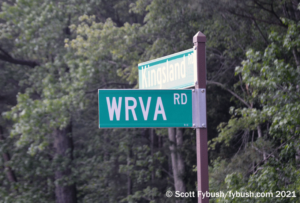
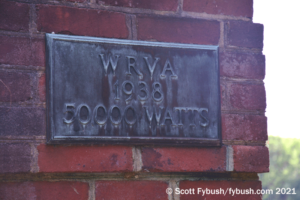
With that goal achieved, what comes next on the list? There are still a few I-As I haven’t seen from the inside (WWL in New Orleans, WOAI, WTAM in Cleveland, and the relocated WBBM in Chicago, if you’re playing along at home) – but there were also a few very important sites in the next category down that remained to be documented.
Even if they never got the full non-directional 50,000 watts of power, the “Class I-B” clear channel stations often boast their own lengthy histories and distinctive transmitter sites – and none of them more so than Richmond, Virginia’s WRVA.
Its site along the James River in rural Henrico County sits 12 miles from downtown Richmond, but it’s just remote enough that we never made it out here on previous visits. In the spring of 2021, though, our one day whirlwind visit to Richmond stations unlocked the door here, and what we saw inside was just bursting with history.
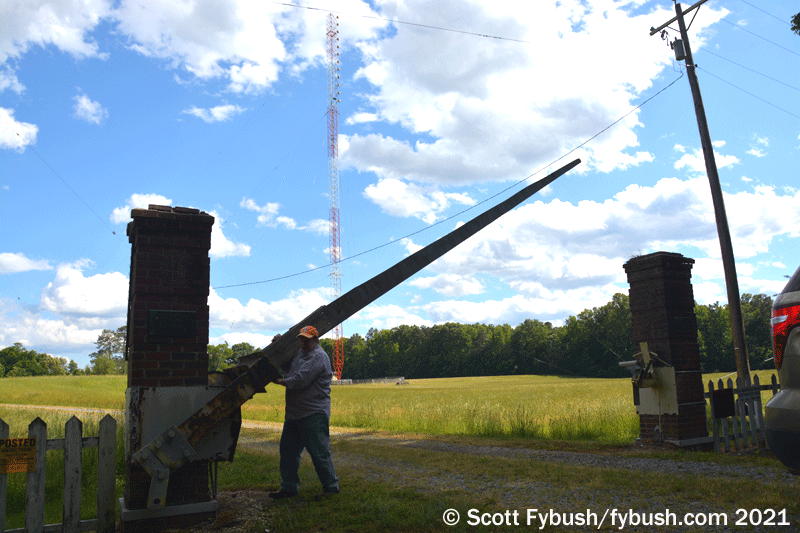
The remoteness of this site is a little deceptive – these days, it’s just a couple of miles from here to the I-295 Richmond outer beltway, then a few turns off New Market Road until we end up on dirt at the entrance to “WRVA Road.”
But in 1938, when WRVA was seeking a new high-power site to maximize its coverage of eastern Virginia, it would probably have taken half an hour of driving to get here from WRVA’s studios and theater in downtown Richmond, or from the station’s 5000-watt transmitter site in Mechanicsville, northeast of Richmond, where a much-publicized new tower had just gone up in 1935.
(The big deal? It was the first “self-supporting, all-wooden” tower, and yes, we scratched our heads about that too. Did it hold up some sort of folded unipole wire antenna? The surviving photos aren’t clear. What we do know, though, is that the 1929-vintage Colonial-style brick transmitter building in Mechanicsville still exists with some modifications, now being used as an insurance office, while the rest of that old WRVA site turned into a new housing subdivision just as soon as the station left. The new address on Virginia Manor Drive is just off “Edgeworth Road,” so named because the land in that area belonged to the Larus and Brother tobacco company, which started WRVA at its factory in 1925 – and which applied its “Edgeworth” tobacco brand not only to the road but to the subsidiary that owned WRVA, Edgeworth Broadcasting.)
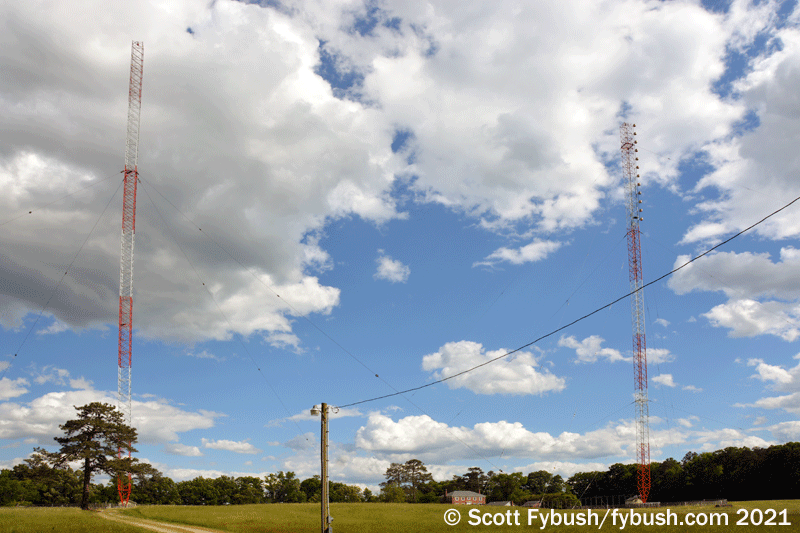
So: it’s 1938, the Larus/Edgeworth ownership is searching for a new location at which it can power WRVA up to 50,000 watts, and it needs to meet a few specific criteria: it wants a site southeast of Richmond to pump as much power not only into the Richmond area but also 70 miles down the James River into the Norfolk/Hampton Roads area, the other major population center in the state.
(How important was Norfolk to WRVA? So much so that by 1950, it had established a studio there and had obtained an FM license. WRVC on 102.5 operated for a few years as a partial WRVA simulcast with some local programming before being sold off to local owners; it evolved into what’s now WOWI on 102.9 in Norfolk.)
A third factor also played into the choice of this site: as a class I-B clear channel, WRVA had to consider protection the only other station then operating on its pre-NARBA frequency, 1110 kc. That was KSOO in Sioux Falls, South Dakota, which moved along with WRVA to 1140 in 1941. While KSOO was then a limited-time station, operating only until Richmond sunset, it too upgraded after NARBA to become a full-timer on 1140. (One last bit of irony: the FCC’s history cards for WRVA record that when its engineers were testing prospective new transmitter sites in 1938, their experimental authorization allowed them up to 50 watts on a temporary frequency – of 1140!)
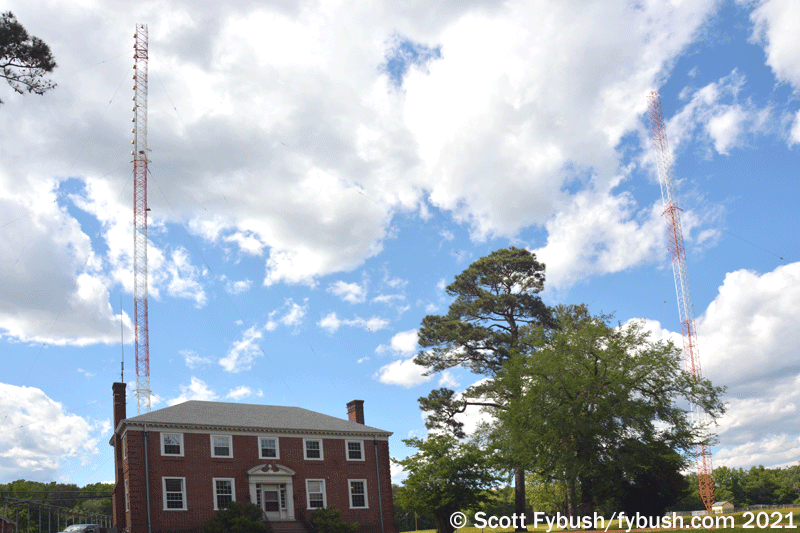
When WRVA made its move out here to the banks of the James, receiving its license to cover on March 6, 1939, it was to a facility that was clearly built both to last and to impress. The original gate at the northern end of the property is still there more than eight decades later, and the mechanism still works. Once you’re past the gate and the brick pillars, you drive around the transmitter field to get to the sturdy Colonial-style brick transmitter building, because what else would a tobacco company build for its radio station before the war?
(WRVA would become much more architecturally adventurous in later years under new owners; in the 1960s, it built a new studio building near downtown that’s recognized even now as a Modernist landmark, though with new tenants after WRVA merged in with other stations north of town under Clear Channel ownership.)
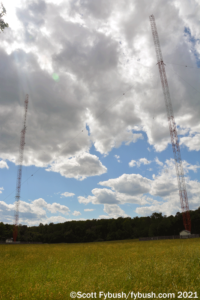
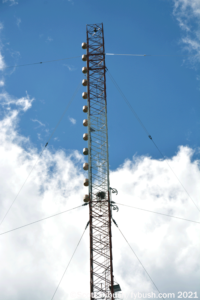
The two towers are original to 1939, and reflect the considerable advancement in understanding of AM transmission science in just the few short years since the “all-wooden self-supporting tower” at Mechanicsville. These are square cross-section steel lattice towers, each 450 feet tall, one of them also holding antennas for WRVA’s FM sister, WRVQ (94.5) – about which more in a bit.
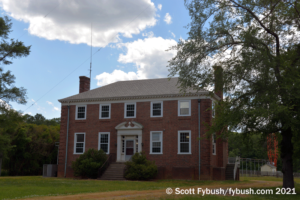
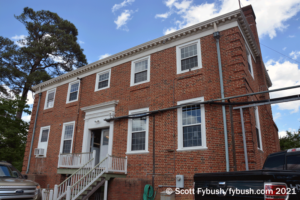
While the “front door” of WRVA’s building faces south, away from the towers toward the river, these days the main entry to the building is on the business side of things, from a little parking area out back that also adjoins several outbuildings, an original wooden storage barn, a smaller building that was used as an apartment for engineers at one point, and a newer large storage barn to the west that’s become a repository for lots of older studio gear as WRVA and its sisters have moved around in recent years.
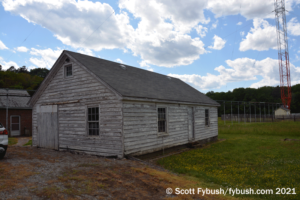
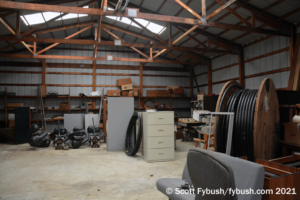
Shall we head inside the transmitter building? If we’d walked in this back door in 1939, we’d have been greeted by a massive Western Electric 407 transmitter filling most of the wall on our right between the back door and the front door, with metal grates spanning the space between the top of the Western Electric and the ceiling. After the Western was removed (by then as an aux) in 1977, most of this wall was replaced by wooden paneling, though the control panel for the phasor still sits by the door in all its Western Electric glory.
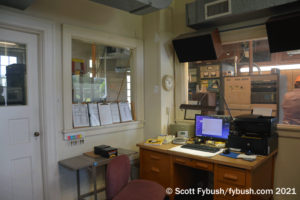
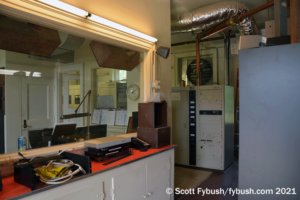
To your left as you enter the back door, there’s an office area that looks much as it did at the beginning, with a big window looking out at where the Western used to be and at the current WRVA and WRVQ transmitters that now form an L shape around the office.
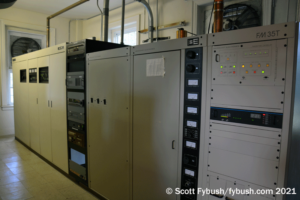
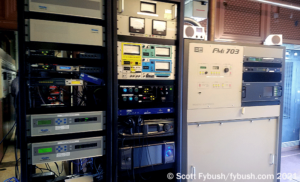
The current transmitter lineup is functional, if a little unromantic: a Harris DX50 powers WRVA, with a BE sitting next to it providing the considerable oomph for WRVQ’s superpower 200 kW signal. Around the corner, in what was once the hallway in front of the Western Electric, there are STL and processing racks and the BE transmitter for WRVQ’s HD signal.
A little FM history here: WRVA entered the FM fray just after World War II, launching what was then called WRVB on 97.1, then 95.9 and finally on 94.5 – but not from this site. The new WRVB got a tower and transmitter site of its own, west of Richmond on Midlothian Pike, with considerable foresight. Knowing it wanted to get into television, WRVA built the Midlothian Pike site as a future TV studio/transmitter property, a prophecy that came true when WRVA-TV signed on there in 1956 on channel 12. (It’s still there today, many owners later, as NBC affiliate WWBT.)
After the TV station signed on, WRVA decided to go for superpower on the FM signal at just about the last moment before the FCC slammed the door on those moves: in 1961, it relocated what was then WRVA-FM out here to the AM site. As with so many of those superpower FMs, the tradeoff doesn’t look great in retrospect – while 200 kW pushes the signal down the peninsula and almost to the Hampton Roads, it’s not very high up here, it’s not very close to Richmond, and so the WRVQ signal isn’t any better over most of its home market than its standard class B competitors.
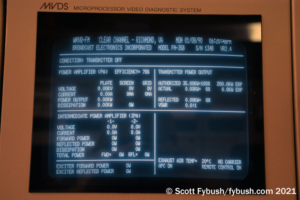
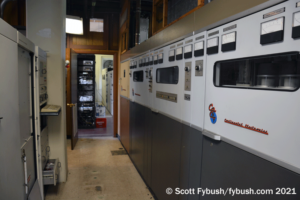
Back in what was originally the space behind the Western Electric, there’s WRVA’s backup transmitter, a Continental 317 that arrived in the 1970s, replacing the RCA BTA-50H that had replaced the Western.
There’s also an older BE transmitter here for WRVQ’s backup (the screen still works!), and behind it a parts storage area in an enclosure behind the original phasor.
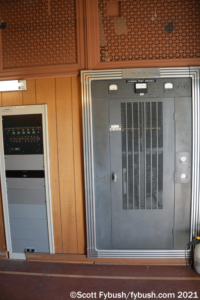
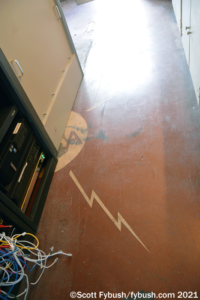
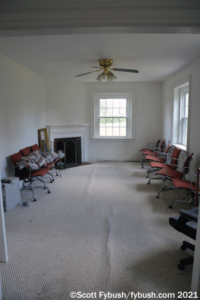
Back out in the hallway, we get another look at the vintage lightning-bolt flooring with the WRVA calls that sits under the WRVQ HD rig, as well as the remaining panel from the Western and, next to it, an antenna control panel of later vintage.
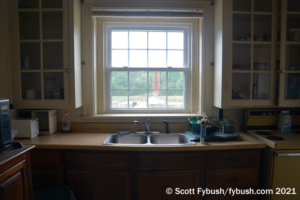
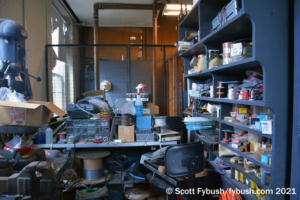
The second floor, accessed through a separate side entrance outdoors, was built as an apartment for the transmitter engineers, and it’s still a pretty space (imagine having your breakfast and coffee at the kitchen counter with those towers as your wakeup view!) even if it’s mostly just used to store old office furniture these days.
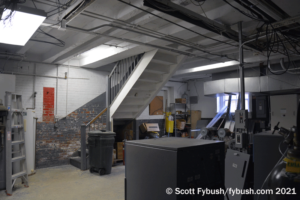
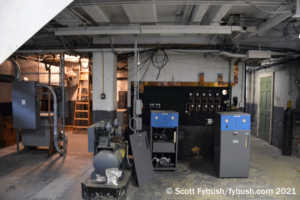
And down in the basement, accessed through a stairwell off the engineering office, we find more storage, a lot of power handling, and ghosts galore – the power transformers from the original Western lived down here, of course, in a walled-off space near where the transmission lines exit to head out to the two towers and carry WRVA’s 50,000-watt voice out to the mid-South and the entire East Coast at night.
THE CLOCK IS TICKING…
As we announced a few weeks ago, the 2026 edition of the Tower Site Calendar will be the last.
We began publishing it 25 years ago, and the broadcast landscape is radically different now.
Radio World just ran an excellent article about us if you want to know more.
Once it’s gone, that’s it. We won’t be printing any more.
Thank you to everyone who saw our announcement and rushed to buy it. We appreciate you.
(There are some calendars from previous years if you want more of a tower photo fix — all under $5.)
But don’t wait to get this year’s Tower Site Calendar — buy it now!
We are selling the Broadcast Historian’s Calendar again this year, but we have that in an even smaller quantity — definitely don’t hesitate for that.
And visit the Fybush Media Store to check out our selection of books and videos, too!
And don’t miss a big batch of Richmond IDs next Wednesday, over at our sister site, TopHour.com!
Next week: WKHK’s site in Richmond


